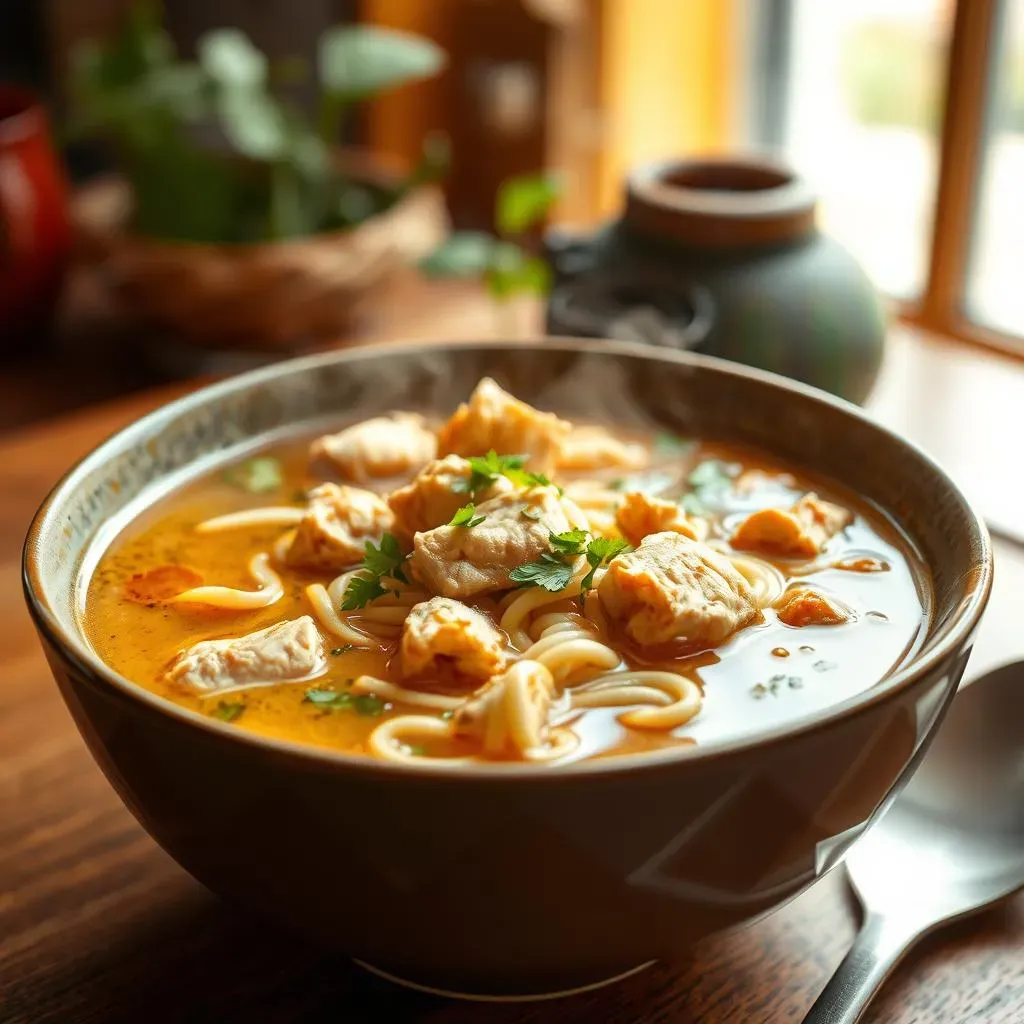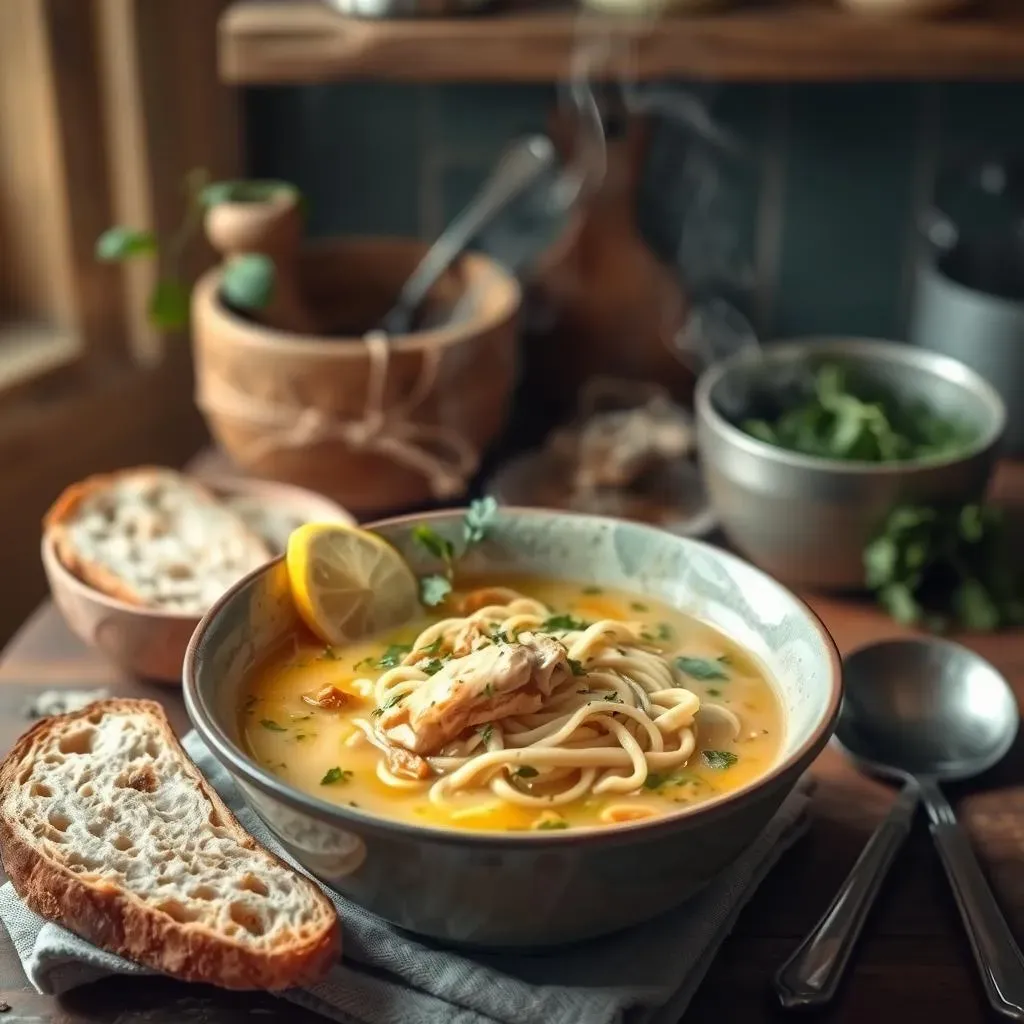Table of Contents
Ever wondered if vegans can enjoy a warm bowl of chicken noodle soup? The classic recipe, with its rich chicken broth and tender pieces of chicken, is definitely off-limits for those following a plant-based diet. But don't worry, that doesn't mean missing out on this comforting staple! In this article, we're going to explore how you can recreate a delicious, cruelty-free version that hits all the right spots. We'll look at what makes traditional chicken noodle soup not vegan, and then break down simple swaps for each ingredient, from the broth to the "chicken" and even the noodles. You'll learn how to make a vegan chicken noodle soup that's not just a substitute, but a fantastic dish in its own right. Get ready to discover how easy and satisfying it is to enjoy this classic comfort food, the vegan way! We will also cover storing and serving tips, so you can enjoy it whenever you like.
What Makes Chicken Noodle Soup Not Vegan?

What Makes Chicken Noodle Soup Not Vegan?
The Core Issue: Chicken Broth
The main reason traditional chicken noodle soup isn't vegan is the broth. It's made by simmering chicken bones, meat, and sometimes skin in water. This process extracts flavors and creates a rich, savory base, but it also infuses the broth with animal products, making it a no-go for vegans. The gelatin that comes from the bones is another key element that is not vegan. So, while that comforting flavor is what many people crave, it's the first thing we need to address when making a vegan version.
Think of it like this: if you’re making a soup with beef stock, you wouldn't expect a vegetarian to eat it. It's the same with chicken broth for vegans.
- Chicken broth is the main offender
- It's made from animal parts
- Gelatin from bones is not vegan
The Chicken Pieces
Of course, the second big problem is the chicken itself. Those little chunks of meat that float around in the soup? Definitely not vegan-friendly. For a vegan, eating chicken is like eating a steak for a vegetarian. It's a clear animal product that goes against the core principles of a vegan diet. So, we need a good substitute that not only looks like chicken but also adds a similar texture and protein to the soup.
It's not just about removing the chicken, it's about finding something that can step into its role and make the soup satisfying.
Hidden Non-Vegan Ingredients
Sometimes, there are sneaky non-vegan ingredients that can pop up in chicken noodle soup. For example, some noodles are made with eggs, which obviously aren't vegan. Also, some pre-made broths might have other animal-derived additives or flavorings. It's always a good idea to double-check labels and be aware of what’s going into your meal. This is especially true if you're buying pre-made versions of the soup.
It's like checking the ingredients on a candy bar, you never know what might be lurking!
Ingredient | Why It's Not Vegan |
|---|---|
Chicken Broth | Made from animal bones and meat |
Chicken Meat | Animal product |
Egg Noodles | Contain eggs |
Crafting a Vegan Version of Chicken Noodle Soup

Crafting a Vegan Version of Chicken Noodle Soup
The Broth: The Heart of the Soup
Alright, so we know the chicken broth is a no-go. But that doesn't mean we can't achieve a rich and flavorful base for our vegan soup! The secret is using a good quality vegetable broth. I personally love using "Better Than Bouillon No Chicken Base." It adds a really nice depth of flavor that mimics chicken broth, without any actual chicken. You can also use regular vegetable broth and add some nutritional yeast for a cheesy, umami kick. Think of it as the secret ingredient that will make your soup taste like a hug in a bowl.
It's like switching from regular milk to oat milk, it gives you a similar experience but without the animal product!
"Chicken" Alternatives: Finding the Right Fit
Now, let's talk about the "chicken." There are so many amazing options out there! You can use store-bought vegan chicken pieces, like Tofurky, or seitan. These do a good job of mimicking the texture of real chicken. But if you want a simpler, whole-foods option, chickpeas are a great choice. They add protein and a nice bite to the soup. Some people even use jackfruit, which when cooked right, has a surprisingly chicken-like texture. Experiment with what you like best!
It's like choosing your favorite character in a video game, there are so many options, so pick the one you like the most!
Vegan "Chicken" Option | Texture | Flavor |
|---|---|---|
Vegan Chicken Pieces (Tofurky, etc.) | Similar to cooked chicken | Savory, seasoned |
Seitan | Chewy, dense | Mild, absorbs flavors well |
Chickpeas | Soft, slightly firm | Mild, nutty |
Jackfruit | Tender, shreddable | Mild, takes on flavors well |
Can Vegans Eat Chicken Noodle Soup? Ingredient Swaps

Can Vegans Eat Chicken Noodle Soup? Ingredient Swaps
Noodle Know-How: Choosing Vegan Pasta
Okay, so we've tackled the broth and the "chicken," but what about the noodles? Not all noodles are vegan! Many traditional egg noodles are made with, you guessed it, eggs. So, when you're making a vegan chicken noodle soup, you've got to be a bit choosy. Look for pasta that is specifically labeled as "egg-free" or "vegan." Most dried pasta made from wheat is vegan. My go-to's are usually rotini, penne, or even just regular spaghetti broken into smaller pieces. The idea is to pick a noodle that will hold up well in the soup and give you that comforting slurpy experience. You can also get fancy with rice noodles or gluten-free options if you prefer. It's all about finding what works for you and your taste buds!
It's like picking the right shoes for a hike, you want them to be comfortable and sturdy!
Veggies and Flavor Boosters
Now, let’s talk about the veggies. They are the unsung heroes of any good soup. Carrots, celery, and onions are classic additions to chicken noodle soup, and they're totally vegan. But don't stop there! Feel free to add other vegetables to make your vegan chicken noodle soup even more awesome. Spinach, kale, mushrooms, peas – they all work great. And to really boost the flavor, consider adding some fresh herbs like parsley, thyme, or dill. A little garlic and a bay leaf can also make a big difference. It's all about layering those flavors to make your soup pop.
Think of it as painting a picture, the more colors you add, the more interesting it gets!
Putting It All Together
So, can vegans eat chicken noodle soup? Absolutely, with a few smart swaps! By using vegetable broth, vegan "chicken," egg-free noodles, and lots of yummy veggies, you can create a delicious and satisfying soup that aligns with your vegan values. The key is to focus on flavor and texture, making sure that your vegan version is just as comforting and enjoyable as the original. Don't be afraid to experiment with different combinations of ingredients to find your perfect vegan chicken noodle soup recipe. It's your kitchen, so make it your own!
It's like building with LEGOs, the possibilities are endless!
Original Ingredient | Vegan Swap |
|---|---|
Chicken Broth | Vegetable Broth or "No Chicken" Bouillon |
Chicken Meat | Vegan Chicken Pieces, Seitan, Chickpeas, or Jackfruit |
Egg Noodles | Egg-Free Pasta (Rotini, Penne, Spaghetti) |
Optional Add-ins | Spinach, Kale, Mushrooms, Peas, Fresh Herbs, Garlic |
Serving and Storing Your Vegan Chicken Noodle Soup

Serving and Storing Your Vegan Chicken Noodle Soup
Serving Suggestions
Alright, you've made this amazing vegan chicken noodle soup, now it's time to enjoy it! When serving, ladle the soup into bowls and garnish with some fresh herbs, like parsley or dill, for an extra pop of flavor and color. A squeeze of lemon juice can also brighten up the taste. If you're feeling fancy, you can serve it with a side of crusty bread for dipping. It's like giving your soup a little spa treatment before sending it out into the world!
Think of it like presenting a masterpiece, the garnish and presentation makes a big difference!
For an extra boost of flavor, try adding a pinch of red pepper flakes for a little heat, or a dollop of vegan sour cream for some creaminess. You can also sprinkle some vegan parmesan cheese on top. It's all about making it your own and adding those little touches that make you happy.
Storing Your Leftovers
Now, if you have any leftover soup (and let's be honest, who doesn't love leftovers?), you'll want to store it properly. The key to keeping your noodles from getting mushy is to store them separately from the broth. If you have a lot of soup, you can store the broth in a large container and keep the noodles in a separate smaller container. This way, when you reheat it, the noodles will still have a nice texture. You can also store the whole soup together, but just know the noodles might be a little softer the next day.
It's like keeping your socks separate from your shirts in the laundry, they each need their own space!
- Store broth and noodles separately for best texture.
- Use airtight containers to keep the soup fresh.
- Refrigerate for 3-4 days.
- Freeze for longer storage (up to 3 months).
For freezing, it's best to let the soup cool completely before transferring it to freezer-safe containers. Make sure to leave some space at the top of the container, since liquids expand when frozen. The soup will keep well in the freezer for up to three months, making it a great make-ahead meal. When you're ready to eat it, just thaw it in the fridge overnight and reheat on the stovetop.
Reheating Tips
When reheating your soup, the stovetop is usually the best method. Gently heat the soup over medium heat, stirring occasionally. If the soup seems too thick, you can add a little water or vegetable broth to thin it out. You can also reheat it in the microwave, but be careful not to overheat it, as that can make the noodles mushy. Just heat it in short intervals, stirring in between, until it's nice and warm.
It's like giving your soup a warm hug, gently and lovingly!
Storage Method | Best Use | Tips |
|---|---|---|
Refrigerator | Short-term storage (3-4 days) | Store broth and noodles separately |
Freezer | Long-term storage (up to 3 months) | Cool completely before freezing, leave headspace |
Stovetop Reheat | Best for consistent heating | Heat gently, add liquid if needed |
Microwave Reheat | Quick reheating | Heat in short intervals, stir often |
